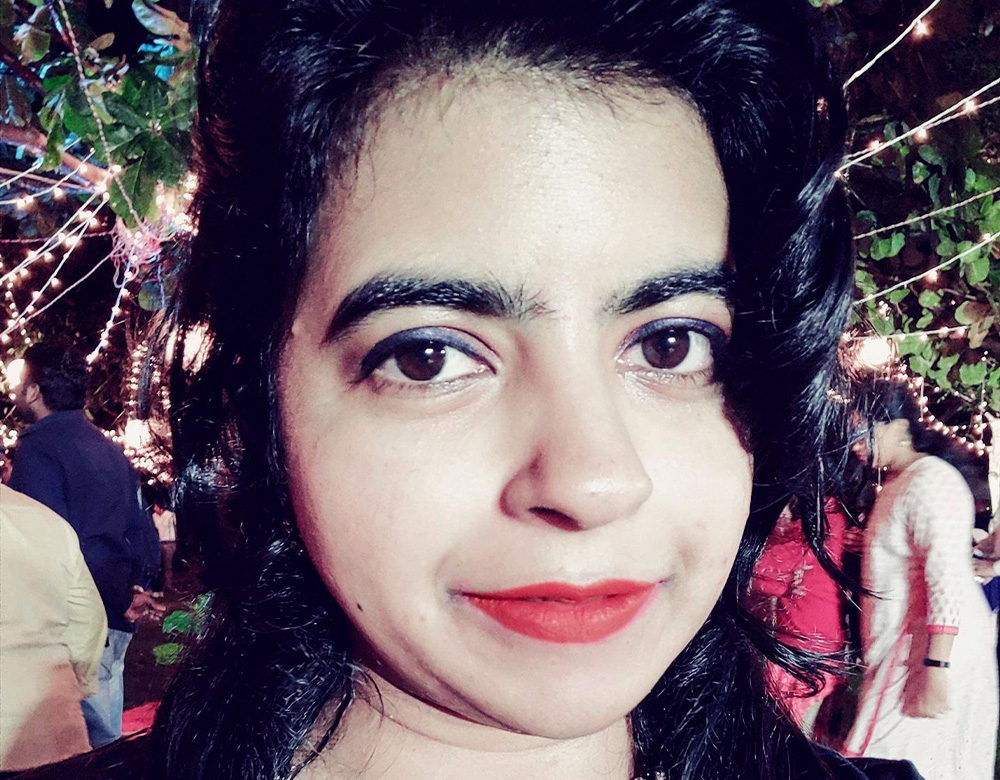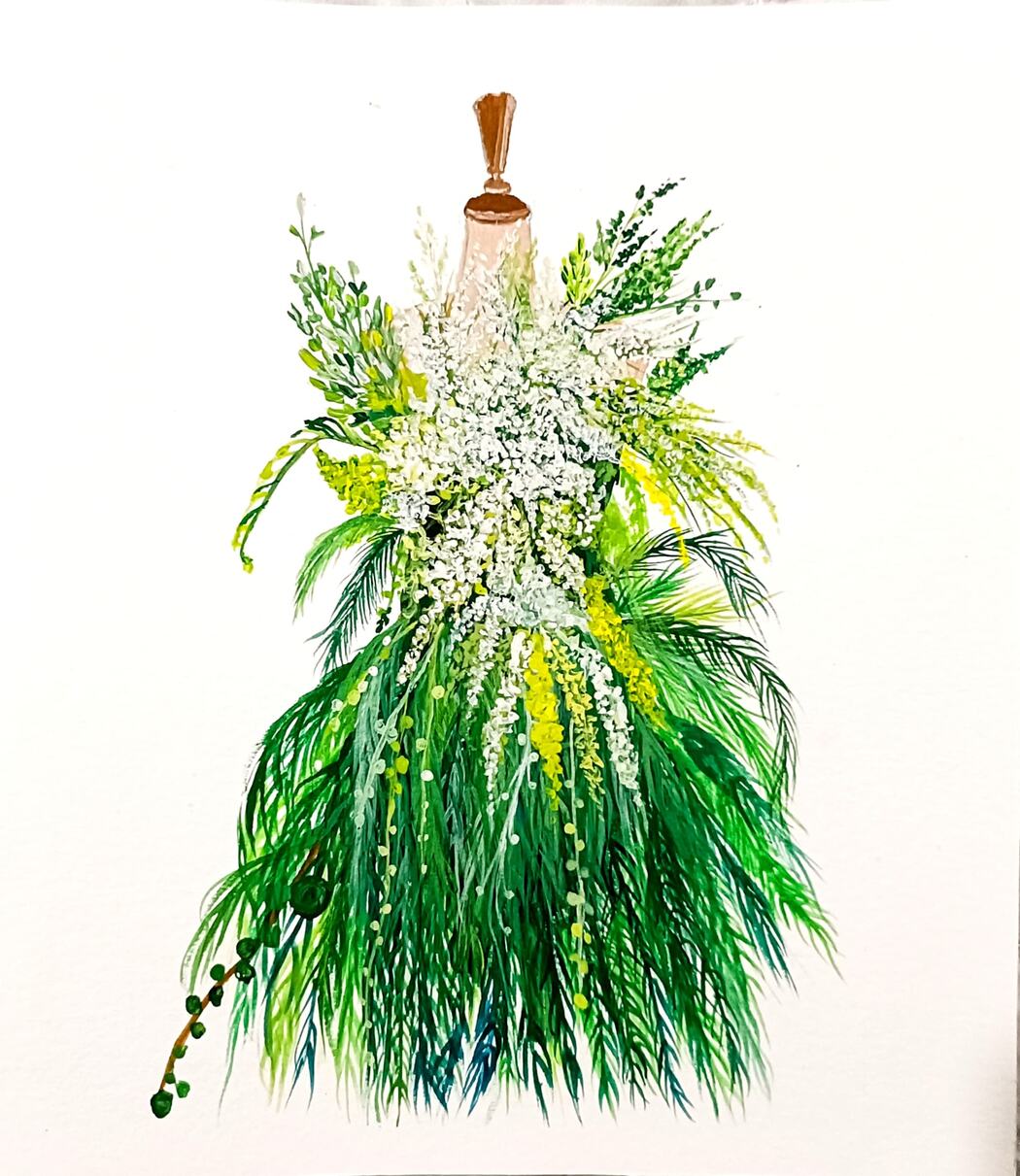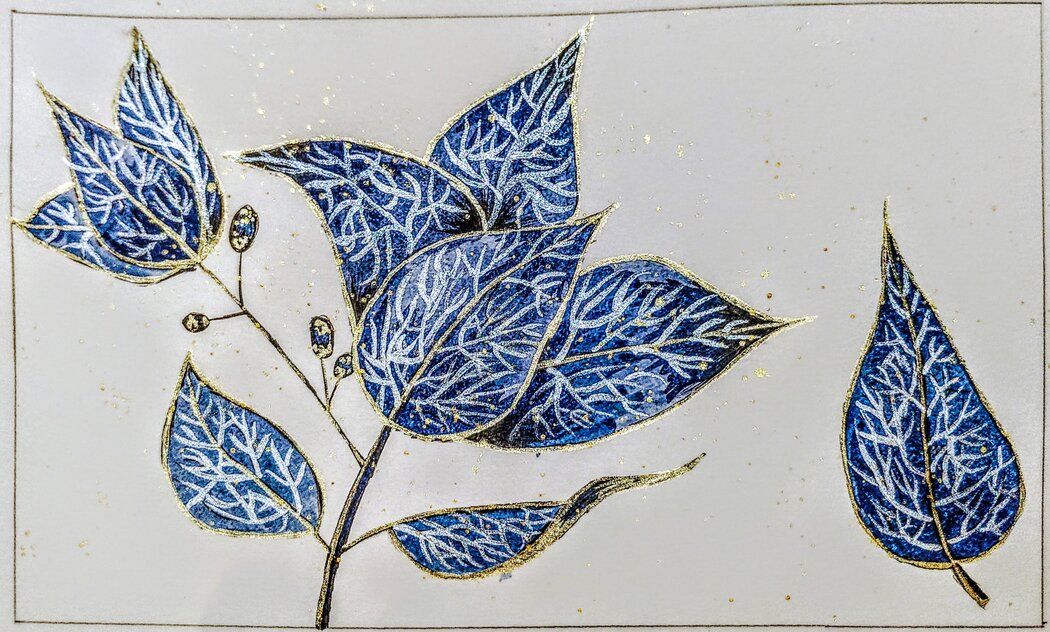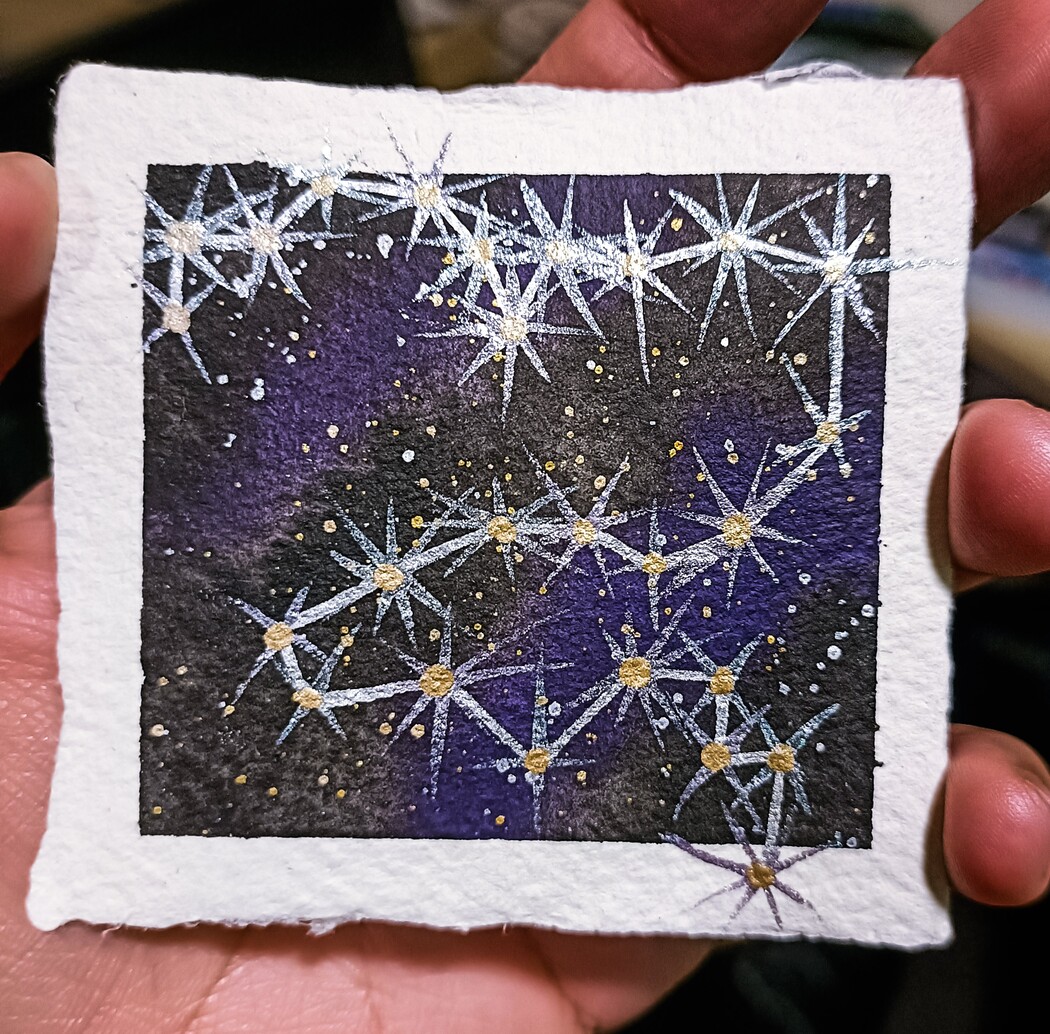Harshita Ezil
Year of birth: 1995
Where do you live: Currently residing at Sheffield, United Kingdom. (Birthplace – Bangalore, India.)
Your education: Bachelor of Engineering in Computer Science at New Horizon College of Engineering, Bangalore, India (2013-2017).
Master of Business Administration [Global MBA] at Sheffield Hallam University, Sheffield, United Kingdom (2021-2023).
Describe your art in three words: Expressive. Vibrant. Versatile.

What inspired you to start working with mixed media, and how do you decide which mediums to use for each piece?
Back in 2019, when I was living in my hometown (Bangalore, India). I used to watch art tutorials on a platform called Skillshare, where there were plenty of videos on how to use mixed media.
Deciding which medium to use is very easy, depending on the piece. For example, if I decided to paint a star map, I would use a watercolour medium to paint the background with the shades of the dark sky. The common shades that I would use are Lamp Black, Dioxazine Purple and Ultramarine Blue. And to paint the constellation lines I would use either Gold Ink or Aluminium Silver Ink. For the stars, I would use metallic watercolour paints.
Another example is, if I decided to make a detailed ink drawing of a floral bouquet, I would draw the bouquet with fine liner pens first and then, I would proceed to include highlights by adding dots on the stamen and precision lines on the flower petals using metallic watercolour paints. To be more specific, if I were to get the precision lines and dots on each petal and stamen, I would use a dip pen, a thin liner brush or a fine detail brush between the size range of .005 to 3.
Can you talk about your process when creating constellations and botanicals in your work? Do you approach each piece differently?
Yes, I approach each piece differently, especially if they are detailed. The most common mediums that I use for constellations are Winsor & Newton artist-grade watercolour paints, Winsor & Newton Metallic Inks, Winsor & Newton Indian Ink, Royal & Langnickel Pearlescent Paints and Gansai Tambi Metallic Watercolour Paints.
The process of creating constellations falls in two categories. i.e. – i) Creating a individual constellation piece. ii) Creating numerous constellations within a star map.
If I were to begin creating an individual constellation piece, for example, the constellation Orion. I would choose a Khadi watercolor paper weighing between 210 to 640 GSM. I would tape the paper on the sides in order to create a border around the paper and then wet the paper all over with a light wash of plain water. And then I would include shades of Lamp Black, Ultramarine Blue and Dioxazine Purple on my paint pallette, dilute them a bit with water and then I gently spread these shades of paint across the light wash, in order to create different shades of the dark sky. I let the background dry naturally and once it’s 80 to 90 percent dry, I blowdry on top of the painting using a hairdryer, so that the paper stays flat and does not bend. Once it is dry, then I proceed by drawing the Orion constellation using an Aluminium Silver Ink by Winsor & Newton. I draw the constellation using a fine detail brush ranging from .005 to 3.
After drawing the constellation, I paint stars on each point of the constellation with a thin fine detail brush in order to maintain precision. I usually use Champagne Gold watercolour paint to paint the stars. I then proceed to add dots to the middle of each star using a darker shade such as Yellow Gold to make the constellation pop. For the final detail. I sprinkle two shades of gold i.e. – Red Gold and Light Gold, in order to define little stars on the background night sky. The painting is allowed to dry naturally. Once the piece is finished, I put them on sale on my online Etsy shop. Some of the constellation pieces, they either remain in my sketchbook or in a plastic folder.
Speaking of star maps, the process is the same as above, just that the differences involve the following – i) I start by generating a specific star map region on a website called Astrodienst, by providing a location. Astrodienst then generates the starmap and I then choose the size of paper and materials to be used, respectively. ii) I, then, choose a larger size watercolor paper by Fabriano, cut it into a size of, say, 30 x 30 cm and tape the corners onto a surface. iii) After painting the sky, I sprinkle different shades of gold with a wet finer liner brush to represent tiny stars on the night sky. If necessary, I include co-ordinates and dotted lines on the map as well, using metallic ink. iv) I proceed further by drawing multiple constellations each, across the already painted night sky and make sure that the constellations are drawn such that their size fits on the paper. The points of each constellation are covered by dots using different colours of pearlescent paints by Royal & Langnickel. v) The finished piece is then framed and sent to the person who made the order.
The first time I ever made a star map, was for my best friend, Madhan. I made one for his 27th birthday last year. Making one for him inspired me to create customized star maps for people, based on their location and where they were born.
Speaking of the creativity of botanicals, I look up reference photos on Pinterest to collect ideas on how to execute my next piece.
For example, if I were to choose to paint a floral archway (wedding version), I look at 5-6 photos of them on Pinterest and observe the differences color schemes and symmetry.
I then, draw the rough sketch of the floral arch from my imagination and pick the colour pallette to my liking. I take a solid 30-40 minutes to draw the floral arch with a HB pencil. Then, I paint the background, the floral details from dark to light step-by-step, till I finally finish the piece. I take 3-5 hours to finish a floral archway piece. I usually use Gouache paints to paint botanicals on paper. If it was a dense surface, say a stretched canvas, I use artist-grade acrylic paints from Winsor & Newton and Pebeo Studio Acrylics. For hologram effects to be added on the floral archway, I use Rico Art Metallic Paints (Acrylics).
Another example is, if I were to paint a bouquet using charcoal. I specifically use willow charcoal by Cretacolor. After I finish executing the piece, I spray the finished piece with a fixative spray and add couple of drops of pearlescent watercolor paint to give the bouquet a finishing touch.
My preferred art supply brands are Winsor & Newton Artist-Grade Paints (Acrylic & Watercolour), Winsor & Newton Metallic Inks, Pebeo Studio Acrylics, Liquitex Basics Acrylic, Cretacolor Black Box Charcoal Drawing Set and Royal & Langnickel Pearlescent Watercolour Paints. I always purchase good quality art supplies and ensure to use them long-term.

How does living in Sheffield, United Kingdom, influence your art? Are there any specific local elements that inspire your work?
Sheffield is personally home to numerous artists. It does have many art museums especially Graves Gallery and Millennium Gallery. It also encourages local artists to partake in art exhibitions hosted seasonally across the city. Artists within Sheffield build communities and encourage each other to create.
There is one particular local place that inspires my work. The Millennium Gallery has a separate museum specifically for John Ruskin, an English polymath, who did indeed paint botanicals as a specimen. He painted them specifically using watercolors and used a liner brush to paint them with a unique, yet fine precision. His botanical works in watercolor is what inspired me to create botanical art pieces in the first place.
Another local element that inspires me to paint botanicals is the Sheffield Botanical Gardens. Sheffield, being the greenest city in Europe is well known for it’s greenery, colourful gardens and floristry. Sheffield Botanical Gardens inspires me to paint floral archways, floral dresses on a mannequin and floral bouquets with detail. Some botanical pieces of mine with the finest detail take between 5 days to 2 weeks to finish creating. Such is the dedication to my work.
Your Etsy shop features a variety of your artworks. How do you select which pieces to sell, and what role does your shop play in your artistic journey?
Yes, I do sell a variety of artworks and place them in separate categories on my Etsy shop.
For example, if I plan to sell paintings called “Constellation Series”, I first make sure to finish painting 20 individuals pieces of each constellation and keep them ready. Out of the 20 pieces, I choose to sell 15 pieces by making a listing for each of the 15 pieces. After the listings are published, I create a separate category on my Etsy shop called “Constellation Series” and drop the 15 listings into that category respectively. This helps new visitors and buyers navigate my Etsy shop with ease.
The role that my shop plays in my artistic journey is that, it has helped me become a self-made entrepreneur. Running my Etsy shop has taught me that I do not have to be perfect to create and sell art. The times where I felt extreme discouragement, I would use that discouragement as motivation to look up other artists on Etsy and explore the products that they placed on sale. I would then record my observations on my notepad and experiment accordingly, especially with pricing, marketing and presentation. During the experimentation process, I learnt all the things that I was doing right and all the things that I was doing wrong. It does greatly help in the growth process of running my Etsy shop, since it has invited several opportunities for artistic expansion.
Additionally, making art pieces to put up for sale on my Etsy shop, has motivated me to partake in art exhibitions within and outside Britain, respectively. I just got selected to exhibit my artworks in France and I am quite grateful for the opportunity. It will be my first exhibition abroad and I am quite excited about it!

You incorporate botanical themes in many of your works. How do you see the connection between nature and art in your practice?
Taking a walk around nature gives me peace. My favourite park in Sheffield is none other than Weston Park. I love the greenery, the trees and the peace that it exudes.
On the other hand, viewing artwork that involves nature and landscapes gives me so much peace. It inspires me to experiment with colour theory. So that the botanical art pieces I create appear vibrant and colourful.
The connection with nature and art in my practice involves visualization and observation of symmetry. Attributes such as direction of light source, size of the object, attention to detail are considered. For example, if I were to paint from a reference picture of my cousin’s treehouse located in Lemwerder, Germany. I would consider the direction of the light source and create a separate customized colour palette based on the colours present on the reference picture. I would start by painting the background as the first layer, the darker base as the second layer and the finer details as the third layer. Finishing the art piece provides me with the feeling of being rewarded, post the completion of my art piece.
On the other hand, painting elements from nature helps lower my anxiety and stress levels. Incorporating nature into my art, sets me into a state of serenity.
Can you describe how you use different painting mediums like acrylics, inks, and gouache to bring your pieces to life?
As a mixed media artist, I see creating art as, simply having fun. Having fun while executing the creative process. Similar to how a little kid loves playing video games on a computer.
When it comes to acrylics, I begin by painting an art piece with regular acrylic paints. After the painting is finished, I use metallic acrylic paints to add highlights and finishing touches to the painting.
One fine example is, I once made a painting called ‘Rose in Symmetry’ back in February 2024. It was a mixed media painting where it had a rose painted in acrylics in the centre and the background around the rose had geometric figures such as squares, triangles and rectangles, painted with gold ink. I remember placing it for sale for £25 and it was purchased within a week by a customer in Yorkshire. It felt special to know that I could add value to my buyers through the creation of mixed media art pieces.
Another example is, when I draw and paint a fruit, say blueberries, I first draw them lightly on paper using a mechanical pencil and then paint it realistically using gouache. For the finishing touch, I use pearlescent watercolor paint that matches the colour of the blueberries and I proceed to add the colour as highlights. The highlights provide a hologram effect.
Besides adding finishing touches to the paint, regardless of the medium, trusting the process is what matters the most when it comes to bringing my paintings to life. It is the main element that influences viewers of my art pieces to invoke appeal and admiration towards my artworks, respectively.

How do you balance your creative practice with the business side of things, such as managing your Etsy shop and promoting your art?
I actually execute both actions simultaneously. This can be demonstrated with two instances.
For instance, after I complete the publication of a single listing, I copy that listing link and picture, send it to my Instagram story and post. Instagram has a feature called ‘Crossposting’, which automatically sets up my stories and posts to Facebook, without my having to manually go on Facebook and post the same things again, which saves me a lot of time. Alternatively, all my Etsy listings have SEO titles on them, with the original title and detailed description listed in the ‘Description’ section of the listing. This allows for expansion and distribution of the visibility of each listing not only within Etsy, but outside Etsy as well. Etsy does permit the generation of Direct Traffic via SEOs into their website. Which guides the visitors and buyers to the sellers on Etsy. In this way, there is no need for me to pay for Etsy ads, or even Facebook ads.
When it comes to promoting my art, I ensure to do it both online and offline. When I promote my art online, I make to post my artwork as often as possible in order to keep my audience engaged and my social media active, simultaneously. While promoting my art offline, I really put myself out there by taking part in art exhibitions. I get to meet new artists in these art exhibitions and get the chance to know more about their works. I also had attempted to ask shops to put up my art pieces on display. It has been quite the journey as an artist indeed.


Leave a Reply